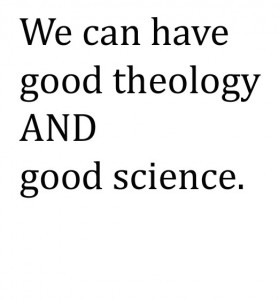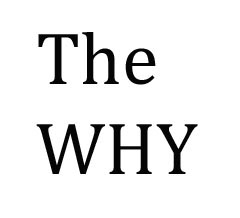Creation? Seriously?
It’s just not what you think. Read what I have to say here and you’ll be surprised. All the trumped up conflict between the Bible and science is a crock. I believe in good theology, but I also believe in good science, and you don’t have to trash one to have the other.
up conflict between the Bible and science is a crock. I believe in good theology, but I also believe in good science, and you don’t have to trash one to have the other.
Here’s the deal: I believe that the understanding of Genesis 1-2 that has been popular for the past 300 years (the age of Enlightenment and the age of Reasoning) is a total misunderstanding of the text. Current research is taking the text back to its original roots and discovering a completely different, and, I believe, a more accurate meaning. (How’s THAT for a start to a letter?)
To summarize, Genesis 1 is about function, not structure. In other words, God is not telling us WHAT he created, but WHY—what its purpose is. Science tells us the “what”; God tells us the “why” (something science doesn’t and can’t talk about). For instance, on Day 1 God is not creating light and dark—they already existed. But he is giving them their role—their function—in keeping time. Understand? God isn’t creating the things, but he is giving them their purpose: to keep time. We’re mistreating the text by trying to make it conform to our scientific world view. It’s not a scientific piece of writing. Genesis 1 tells what happened when God began His creative work, meaning that the author tells us how God used the raw material (which, the Bible says, God created, but that wasn’t the concern of the writer of Gen. 1).
 OK, here it is: light already existed, but in Gn. 1.3 God is assigning to it the purpose of light and dark: to keep time. That’s what it’s about: not WHAT is there, but WHY it is there. The text isn’t concerned about things. What it’s about is that God is taking responsibility for imposing order on chaos. God is using his power and sovereignty to give the universe its purpose.
OK, here it is: light already existed, but in Gn. 1.3 God is assigning to it the purpose of light and dark: to keep time. That’s what it’s about: not WHAT is there, but WHY it is there. The text isn’t concerned about things. What it’s about is that God is taking responsibility for imposing order on chaos. God is using his power and sovereignty to give the universe its purpose.
So that’s what’s going on. What about the other days, you may ask?
Day 2 (vv. 6-8): God is the regulator of climate. You’ll notice that there is nothing mentioned here that God is creating. He is giving purpose to the sky and sea.
Day 3 (vv. 9-13): Agriculture. Again, nothing is being made here, but the ground is being given its purpose.
So far we have that God has set up three functions to bring order to the cosmos: time, weather, and agriculture. Compare this with Gn. 8.22, after the flood, when he does the same thing: “As long as earth endures, seedtime and harvest [agriculture], cold and heat, summer and winter [weather], day and night [time] will never cease.”
Day 4 (vv. 14-19): The sun, moon and stars are given their functions (their purpose): signs, seasons, calendar
Day 5 (vv. 20-23): The fish and birds are given their functions to be subservient to people. In v. 20, you see the birds and fish are placed where they will live and breed, and that’s what the role will be of these classes of creature (notice, not species). Though humans exercise rule over the animals in general, the fish and birds occupy a different realm, sea and sky, where they carry out their functions.
Day 6 (vv. 24-31): The living creatures, including humans, are given their purpose.
You see? The text is not about the stuff—that’s for science. It’s about purpose—that’s for God. The Bible doesn’t try to tell us about the structures. Instead, it tells us what the purpose is—why it’s there. Science can’t tell us anything about purpose—about “why” things happen: science just observes cause and effect and explains it, telling us as much about it as it can. Science and theology are a perfect complement to each other.
And what about Day 7: the Day of Rest? The point of Gen. 1, it turns out, is to show us that God was setting up his Temple: the place for him to set up his throne and to make his presence known. It’ll be easier if I just quote another:**
“Rest is the main goal of Creation. The functional cosmos is not set up with only people in mind. The cosmos is also intended to carry out a function related to God. On the seventh day we finally discover that God has been working to achieve a rest. This seventh day is not a theological appendix to the creation account, just to bring closure now that the main event of creating people has been reported. It intimates the purpose of creation and of the cosmos. God does not only set up the cosmos so that people will have a place. He also sets up the cosmos to serve as his temple. As Wenham observes, the creation of people may be the climax of the six days of work, but it is not the conclusion of the narrative. He goes on to point out that it is the seventh day that is blessed and sanctified, suggesting the significance of what happens there.
“The Cosmos is portrayed as a Temple Complex in the Bible. Isa. 66:1 expresses clearly the temple/cosmos function in biblical theology as it identifies heaven as his throne, earth as his footstool, providing a resting-place for him. He likewise achieves rest on the seventh day of creation, just as he takes up rest in his temple (see below). As developed earlier, “rest” does not imply relaxation, but more like achieving equilibrium and stability. The environment he creates is not intended to provide rest for the people he has created (though that becomes a significant piece of theology as time goes on). Rather, he is making a rest for himself, a rest provided for by the completed cosmos. Inhabiting his resting place is the equivalent to being enthroned—it is connected to taking up his role as sovereign ruler of the cosmos. The temple simply provides a symbolic reality for this concept. Psalm 104:2-4 captures this as the elements of the cosmos serve as functionaries for Yahweh’s rule.
– The luminaries from Day 4 suggest the lamps in the Temple
– Rivers flowing from Eden suggest Ezk. 47.1
– When people are assigned their function in 2:15, priestly terms are used
– Rest is the principle function of the temple, and a temple is always where a deity finds rest
– The cosmos is described in temple terms, and the temple is described in cosmos terms (Ps. 132.13-14; Ex. 40.34; Isa. 6.3; Ps. 78.69)
– Sabbath and sanctuary relate to one another (Lv. 19.30; 26.2)
The face value of the account, that which is mutually understood by the guy who wrote the book as well as the audience of his day, contains at least a strong undercurrent of God setting up a cosmos that is intended to function not only as an environment for the people that he is creating, but even more as a sanctuary for himself. He furbishes it, puts people in it and takes up his repose (Sabbath) in Gen 1:1 – 2:4, then sets up Eden along the lines of the holy of holies.
Why 7 days? That was the recognized period of time to dedicate a temple! 1 Kings 8.62-66.
It’s a beautiful thing, isn’t it? Hey, if you want to discuss this more, make a comment, or go to the Q&A forum. Contact me, and let’s talk.
** Walton, John H., The NIV Application Commentary: Genesis, Zondervan (Grand Rapids, MI), 2001, p. 148
